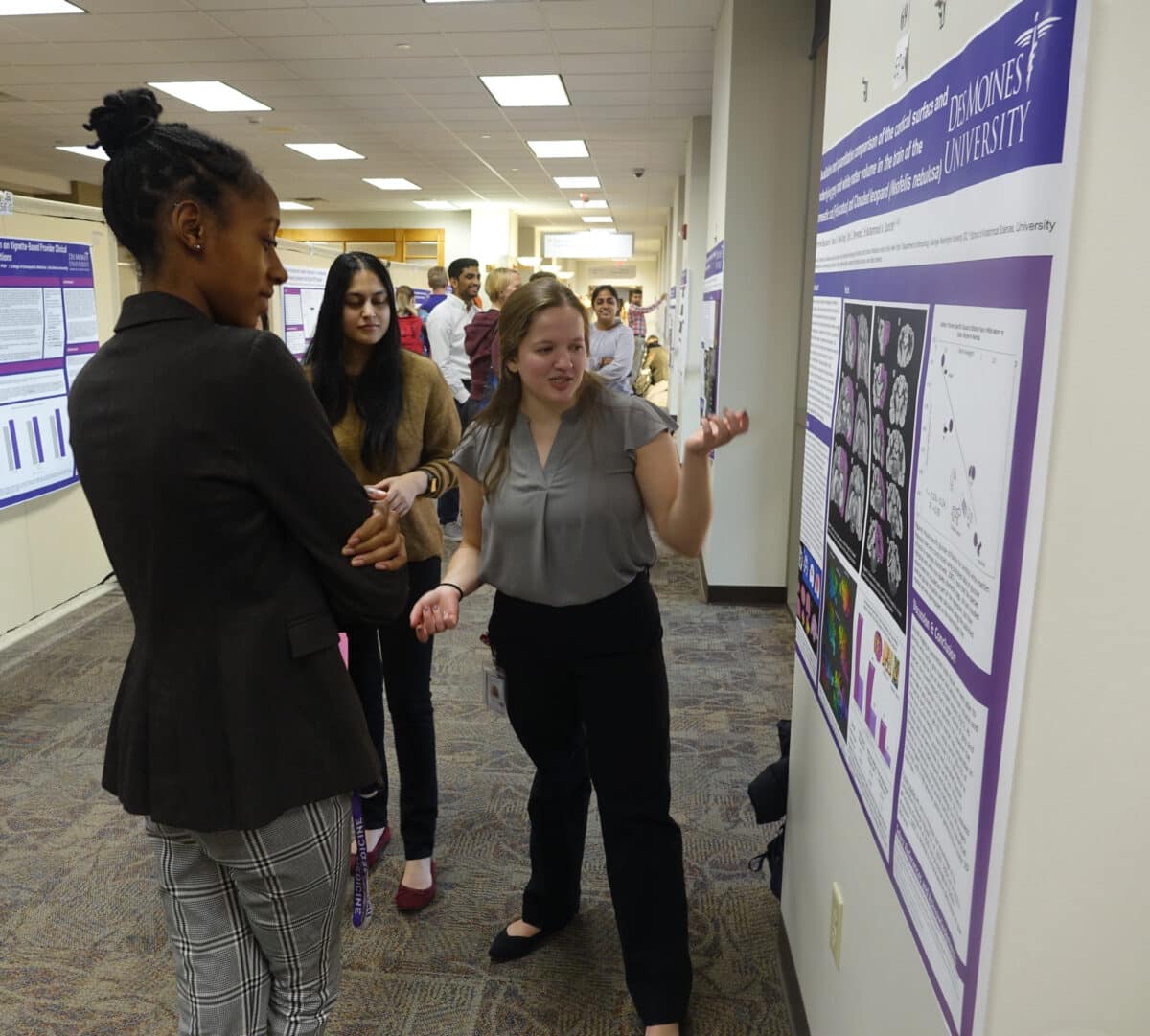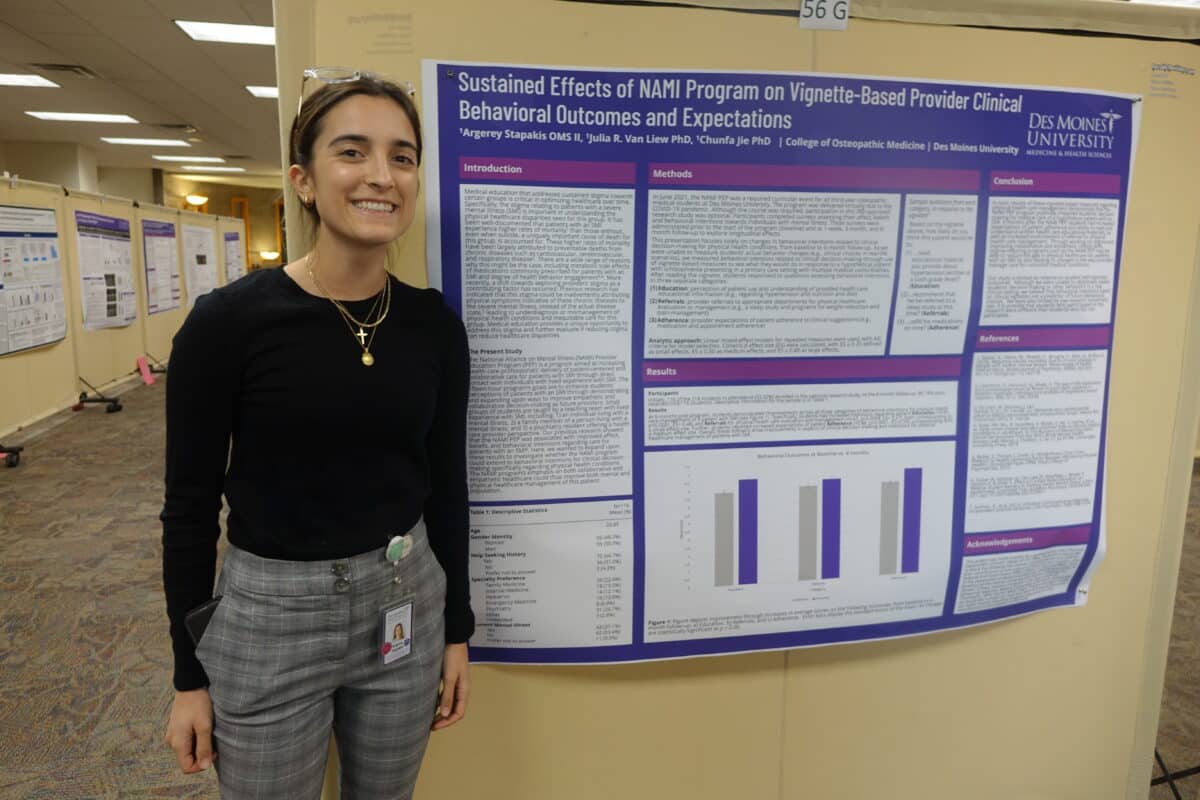The large crowd that attended Des Moines University’s 13th annual Research Symposium on Dec. 1 reflected diverse scientific interests and great excitement for an in-person opportunity to explore them.

“It’s clear from the 79 posters and eight oral presentations planned for today that it will be a great day where we learn about student and faculty research and how they are finding ways to solve present problems and, in some cases, showcase exceptional breakthroughs in health, science and related fields,” said Abigail Amissah-Arthur, Ph.D., executive director of research at DMU. “In times of crisis, immense creativity often comes to the fore, precipitating major changes. This has been the case in the COVID-19 era in 2020 and 2021.
“The COVID-19 pandemic forced health care into the future and, as a result, several promising medical technologies were tested on a massive scale. Those technologies help providers manage their patients better by reducing the dangers inherent in personal contact, waiting in crowded waiting rooms or labs and hospitalizations,” she added.

One very promising medical technology was the topic of the keynote address by Balaji Narasimhan, Ph.D., the Anson Marston Distinguished Professor and Vlasta Klima Balloun Faculty Chair at Iowa State University and director of the Nanovaccine Institute, an interdisciplinary consortium of universities, national laboratories, research institutes, companies and hospitals focused on the design and development of next-generation nanovaccines and nanotherapeutics.
These tools are invaluable, Narasimhan said, given the nation’s aging population and inevitability of more pandemics. The use of nanoparticles as a way to deliver vaccine-related payloads offers numerous advantages, including multifactorial, broad-based and longer lasting immunity; needle-free administration via inhaler or skin patch; room-temperature stability; ability to be customized for specific populations; lower price; and shorter manufacturing times. Because they can be self-administered, nanovaccines require fewer health care professionals and can be more easily mass-distributed. They’ve also demonstrated promising applications for reducing cancer cells with a fraction of the chemotherapy now required.
“So whenever that next pandemic is going to roll around, which we know is going to happen at some point, we hope you don’t have to stand in line or that labs like yours and mine don’t run out of negative-80 [degree] freezers, because CVS and Walgreen’s and HyVee were stacking up on those freezers,” he said. “This is hopefully the future of how we’re all going to deal with that next pandemic when it rolls around.”
Narasimhan noted that Iowa is in good position to become a leader in this work with the research infrastructure of its universities, the regulatory expertise of the Center for Veterinary Biologics in Ames, IA, and the number of companies involved in vaccine development. He referred to a Fort Dodge, IA, company he’d recently learned about that first made vaccines 112 years ago.
“Iowa has a rich history, and if we can invest in these types of technologies in the state, we can become a vaccine hub,” he said. “It’s very encouraging to see that there are opportunities for the state to recognize not just the scientific impact, but also the economic impact.”

The oral and poster presentations given by students at the Research Symposium covered topics in anatomy and paleontology, biomedical science, clinical research, movement science, public health, and education research in the health sciences. The following received honors for their work:
- Best oral presentation, Jacob Bogost, D.O.’25, “Artificial intelligence algorithm for measurement of geographic atrophy”
- Best poster, biomedical science 1, Priyanka Gadkari, D.O.’25, “Dysregulation of hepatic microcirculatory function and tissue oxygenation in a rodent model of sleep apnea”
- Best poster, biomedical science 2, Tanner Wetzel, D.O./Ph.D.’27, “Loss of T cell cytosolic and mitochondrial branched-chain amino transferase increases interferon gamma secretion in hypotolerant and activated T cells”
- Best poster, clinical, Connor Frawley, D.O.’25, and Adam Schweitzer, D.O.’25, “A proposed scapular dyskinesis assessment method/protocol to be used in the clinical setting”
- Best poster, public health, Emma Ferguson, M.P.H.’23, “Fetal monitoring mHealth apps: a mixed-methods study of user perceptions of app effects”
- Best poster, education, Argerey Stapakis, D.O.’25, “Sustained effects of NAMI program on vignette-based provider clinical behavioral outcomes and expectations”
- Best poster, movement science, Angela Palant, D.O.’25, and Taylor Alexander, D.O.’25, “Scapulothoracic motion restriction effect on muscle activation level and its implications to glenohumeral joint injury”
- Best poster, anatomy/paleontology, Alexis VanBaarle, M.S.A.’23, “Comparing two forensic anthropological programs used for sex and ancestry estimation”

Unable to attend the Research Symposium this year? View a recording of the symposium below.

